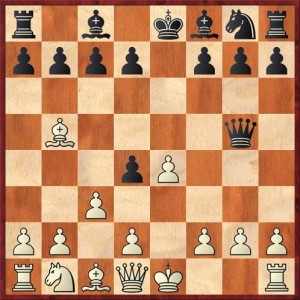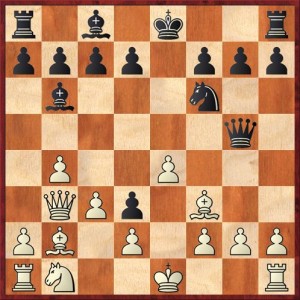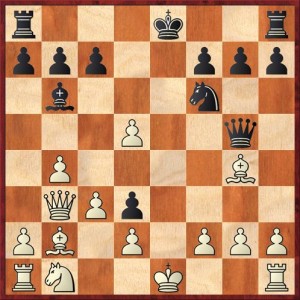If any of you were wondering about the chess position in the photograph in my last post, here is the game. It removes some of the mystery about when and why the photograph was taken.
The game was played in the Monterey Chess Center monthly tournament on February 24, 2002. I remember it well because Ted Yudacufski awarded me a brilliancy prize for it (which I think was $10). I don’t think he awarded one every month, only when there was a game that he especially liked.
Although the picture could have been taken that day, I think that it was more likely taken the next time I played in Monterey, which was September 22, 2002. I suspect that Ted took the photograph himself when he awarded me the prize.
My opponent was Ramesh Mantri, a class-A player. You can play the game over in the PGN viewer, or look at some of the key moments below.
The opening was the Bird Variation of the Ruy Lopez, 1. e4 e5 2. Nf3 Nc6 3. Bb5 Nd4 4. Nxd4 ed, and White walked right into the trap, 5. c3? Qg5!
FEN: r1b1kbnr/pppp1ppp/8/1B4q1/3pP3/2P5/PP1P1PPP/RNBQK2R w KQkq – 0 6
I call this the “Egg on Face Variation,” because White’s best move is to undevelop his bishop with 6. Bf1, admitting that he has made a mistake. If you play the Bird Variation in speed chess or against players rated below 2000, your opponents will walk into this trap fairly frequently. I think that is not sufficient reason in itself to adopt the Bird Variation, but it’s a nice side benefit.
Next, let me show you the move that probably explains why Ted awarded me the brilliancy prize.
FEN: r1b1k2r/pppp1ppp/1b3n2/6q1/1P2P3/1QPp1B2/PB1P1PPP/RN2K2R b KQkq – 0 10
The game had continued 6. Be2 d3 7. Bf3 Bc5 8. b4 Bb6 9. Qb3 Nf6 10. Bb2, leading to the position above. It’s the position just before the one in the photograph in my last blog post. (So if you look carefully at the photo, you’ll see what the solution is!)
The move I played, 10. … d5!, was pretty obvious to me from previous games in the Egg on Face Variation. The pawn sacrifice is more than justified because it enables Black to get more pieces into the attack and it exposes White’s king on the open e-file. Black is simply winning.
However, I almost blundered away my advantage just two moves later. After 10. … d5 Mantri played 11. ed Bg4 12. Bxg4, leading to the position below.
FEN: r3k2r/ppp2ppp/1b3n2/3P2q1/1P4B1/1QPp4/PB1P1PPP/RN2K2R b KQkq – 0 12
Now the question is: What plausible move for Black actually botches the attack?
If you answered 12. … Qe5+?, you’re right! Just because you can play a tactical trick (here, a zwischenzug), it doesn’t mean you should.
I played this move because I wanted to keep White from castling. Unfortunately, it puts my queen on the worst possible square! In the diagrammed position, Black should play the simple and powerful 12. … Nxg4. Now 13. O-O doesn’t solve any of White’s problems, because after 13. … Qh4 he’s going to be mated soon.
Fortunately, my opponent blundered right back with 13. Kf1? and I won very quickly from there. The correct move for White was 13. Kd1 (threatening a skewer on the e-file) 13. … Nxg4 14. c4 (discovering an attack on the queen) Nxf2+ 15. Kc1 and now, with his queen hanging, Black does not have time to capture the rook on h8. In fact, I can’t find a clear win for Black here, although I think that Black still stands better.
Obviously, when Ted awarded me the brilliancy prize, he didn’t know the game was flawed by the double blunder on moves 12-13. I felt a little bit guilty when I discovered this later, but not guilty enough to send back the prize!





